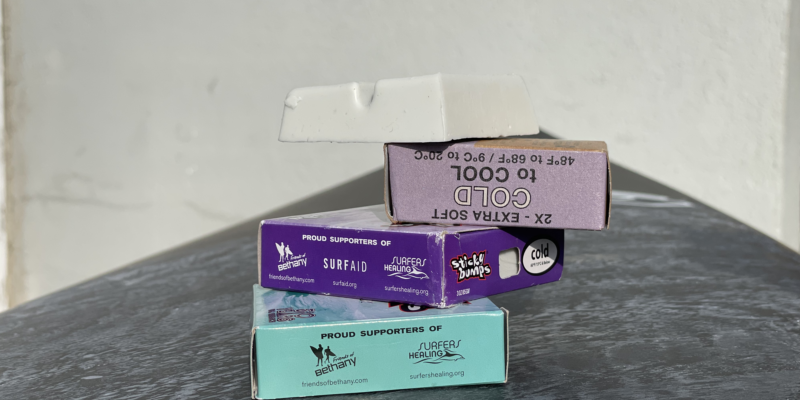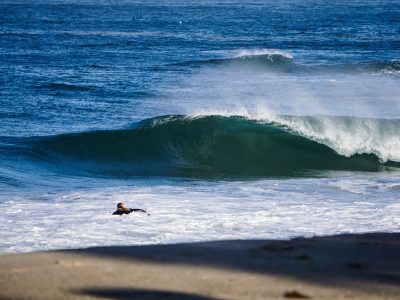Step-by-Step Guide for Beginners
Proper waxing technique is an essential part of your pre-surf prep. Almost everyone has a different style and flair to the way they wax their board. Whether you take the bare-essential approach or want to wax with some style, a proper wax job will make your time in the water more enjoyable and increase your performance.
Whether you’re just learning how to wax a surfboard for the first time or you want to hone your skills, this guide will teach you everything you need to know about how to wax a surfboard. We are going to take you through each of the primary steps of how to wax a surfboard. This article is primarily aimed at those who are new to this practice and want an easy-to-follow, step-by-step tutorial that covers all the essential points of waxing a board.
* Bottom line, proper wax keeps your feet where you want them which in turn leads to better maneuvers and progression.
Step 1: Surfboard Cleaning and Prep
First and foremost, you want to make sure that your board is clean. First, you want to strip the old wax from your old surfboard using a plastic scraper. Next you’re going to want to get all of the old wax, dirt, sand, hair, etc off your deck. For this step use a wax removal product. and a rag or an old t-shirt. These mixtures are generally are less than $10 and will basically act similar to rubbing alcohol and will easily remove any old wax from the board. *If you really want to clean the top, then rub the wax off with a rag or a surf pickle. *Alternatively, you can skip the removal liquid and use a standard cleaning solution or a diluted mixture of baking soda and water, but those aren’t recommended. If you really, want to take the easy route, just place your board in the sun and scrape off the majority of the wax with some sort of plastic scraper (or old credit card you don’t use any longer), but this usually leaves old wax / brown spots on your deck. Remember, the cleaner your surfboard is, the easier it will be to apply the new wax. *Do not use a metal tool to scrape your deck you’ll likely damage the fiberglass. This handy product makes the wax removal job very easy and is recommended
Step 2: Applying Basecoat
The basecoat is the layer that will provide a solid foundation that your final wax will rest upon. Therefore, it is essential to get it right. The best way to do this is to use a basecoat wax. First, you want to make sure that your board is clean. Then, you want to apply a thin layer of wax to your board. *Basecoat if very firm and not meant to be the only wax you apply, this is just the first coat of wax. It should just be enough to cover the surface of your surfboard.
*Tip, if you buy in bulk, the price per bar is much better and this should last you a few years. We usually use sticky bumps
*Also, don’t be a kook and only use basecoat, you will regret it and your feet will slip all over the deck… Not fun…
Step 3: Applying Wax
No you are ready to apply the wax. Some surfers rub the wax in small circles, while others like to rub angled lines across the deck and still others like to wax designs into their patterns or clump lines of wax to help you know where to plant your feet. Whichever method you prefer, make sure you work the wax into the majority of the top of a shortboard (and nearly 100% of the top of a longboard). Most prefer a circular pattern, because it helps make sure you cover every part of the board so you don’t find a blank spot. Most surfers cover the areas where your feet will stand and where your chest will lay, while others say you should coat the entire board in wax. *Some pros like to wax the majority of their shortboard, so their feet don’t slip when their front foot moves up during airs. Longboarders definitely want to wax the full board so you can dance around.
Step 4: Congratulations! You’ve Waxed Your Surfboard
If you’ve followed the above steps, congratulations. You have successfully waxed your first surfboard. Now, it’s time to get out in the water and start improving your skills. As you surf more, you’ll start to learn what you like and don’t like. Some prefer stickier wax than others. If it’s too cold or warm, adjust your wax accordingly. Besides that, there’s not much left to do besides get out there and start surfing.
Tips / Tricks
*If you are removing the wax from a board with wax in it already, let it sit in the sun for 30 minutes, then scrape the wax off with an old credit card. *Make sure you put newspaper or cardboard on the ground, so you don’t ruin you wife/mom’s entryway (then we have bigger problems)
*Buy a wax comb, this will help you get some extra traction on your board after you wax it OR just scrape the wax comb across the top (if you don’t have any wax on hand) as this will give you some traction in a pinch.
*Test some different wax brands to figure out what you like.
Wax Accessories and Other Tools
You don’t need a lot of tools to wax a surfboard, but there are a few that can make the process a lot easier. Here are some of the most essential tools and accessories you need to properly wax your surfboard. Surfboard Wax – This is what you will use to apply a layer of wax to your surfboard. Different waxes have different properties, like hardness. Surfboard Wax Removal – Wax removal is essential for a proper application of new wax. You can purchase a wax removal product at your local surf shop. Alternatively, you can use denatured alcohol.
Surfboard Scraper – Scrapers are useful for removing old wax from your board’s surface. (A good choice here is a scraper from Home Depot or Lowe’s in the drywall section)
Rags or old t shirts – Rags are useful for cleaning your board in step one
Wax Comb

Conclusion
Waxing a surfboard is an essential part of your pre-surf prep. It will make your time in the water more enjoyable and increase your performance. Wax keeps your feet where you want them which in turn leads to better maneuvers and progression. Remember, it’s not just about looking good. It will make your time in the water more enjoyable and increase your performance.
A few video tutorials
What is Surf Wax?
Surf wax today is generally composed of a mixture of paraffin, beeswax or other proprietary formula. It wasn’t that long ago, surfers used candle wax and other gummy substances to keep their feet planted to their boards.
Also, not all surf waxes are created equal. Some are better than others and also more/less toxic to the ocean, so you don’t want to just grab any old wax off the shelf or from Amazon. Make sure you get quality products. Here is a quick list of the best surf wax companies:
Surf Wax Temperatures
If you are a beginner, you might find yourself wondering what type and temperature of wax to use. If you have ever wondered about this, you are not alone. When it comes to proper waxing, you first need to ensure that the temperature of the wax meets the temperature of the water. If you apply “Cold Wax” to your board then surf in warm/tropical waters, the wax will likely be too loose, feel like toothpaste and rub all over your boardshorts or bikini. Alternatively, if you use “warm water” wax while surfing in cold water temperatures like Northern California, your feet will slip around like you have ice skates on your feet.
You want to make sure to check the water temperature before you wax your board and some folks strip their wax every fall/spring.
Generally speaking, there are five surf wax temperatures used and they vary depending on the manufacturer.
Basecoat
Bosecoat wax is what you apply to a new / non-waxed surfboard before your regular surf wax. When you get a new surfboard, or strip all the old wax off a board, this is the first coat of wax. This “base coat” will help any other temperature of wax stick to your board better, and it generally evokes a primal feeling of joy when you’re waxing a board for the first time 🙂
Cold Water Surf Wax
Most wax manufacturers define “Cold Wax” as under 15 degrees celsius, or under 60 degrees Fahrenheit. Most surfers in California use this temperature year round, (unless the water is really warm in the summer). Many surfers apply a lot of cold water wax, since it wears off fairly easily.
Cool Water Surf Wax
“Cool Water” wax generally falls into the temperature range of 14-19 degrees celsius, or 58-68 degrees Fahrenheit. Cool wax is slightly harder than cold wax.
Warm Water Surf Wax
Warm water wax is ideally used in 19-23 degree celsius, or 64-78 degrees Fahrenheit water. This wax is slightly harder than cool wax and a good choice for warmer spring conditions (if you want a stickier deck) or for warmer climates.
Tropical Water Surf Wax
As the name implies, this wax is for tropical surf 23 degrees plus Celsius, or greater than 75 degree Fahrenheit water te. One other note, is that you generally need less wax in warmer water as this wax is much harder than cold wax.
Other content you may enjoy







